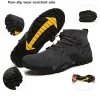Or is it just a “trail runner on steroids”?
Do our shoe gurus have any first hand knowledge?

 www.wsj.com
www.wsj.com
If you don’t want to read the whole article, here’s the first paragraph:
SOMEWHERE IN the liminal space between beefy hiking boots and look-at-me sneakers, you will find Roa’s trail shoes. The 6-year-old Italian label produces fetching footwear that shouts high design more than it does high altitude. Mesh panels add shimmer to sneakers while the sides of an ankle-high boot sport curious green “grass” splotches. But the designs also incorporate trail-conquering tech like tractiony Vibram soles and water-repellent nylon. Ringing in at about $250 and up, Roa’s hoity hybrid hikers don’t come cheap.
Roa is among a handful of brands now offering elevated sneaker-boots. Last year New Balance collaborated with Japanese outdoor label Snow Peak on a space-agey $300 shoe. At slightly less gulp-inducing prices, Nike last year released the Mountain Fly, a shapely $220 Gore-Tex sneaker, as part of its outdoor-focused ACG line, and Reebok has introduced the $180 rubberized DMX Trail Shadow sneaker, inspired by archival designs from the 2000s. While less extravagant than, say, Balenciaga sneakers ($975), these shoes still cost more than the outdoorsy footwear you can pick up at any REI: from Timberland’s Mt. Maddsen boot ($100) to Salomon’s Outline hiking shoe ($130). The question arises: Is a high-price, hybrid sneaker-hiker worth the investment?
Do our shoe gurus have any first hand knowledge?
$300 for Hiking Shoes? Why Outdoorsy Types Are Splurging
Brands like New Balance and Roa are pushing handsome, pricey sneaker-boots purported to perform as well on the mountain trail as on the sidewalk. But are they worth the investment?
If you don’t want to read the whole article, here’s the first paragraph:
SOMEWHERE IN the liminal space between beefy hiking boots and look-at-me sneakers, you will find Roa’s trail shoes. The 6-year-old Italian label produces fetching footwear that shouts high design more than it does high altitude. Mesh panels add shimmer to sneakers while the sides of an ankle-high boot sport curious green “grass” splotches. But the designs also incorporate trail-conquering tech like tractiony Vibram soles and water-repellent nylon. Ringing in at about $250 and up, Roa’s hoity hybrid hikers don’t come cheap.
Roa is among a handful of brands now offering elevated sneaker-boots. Last year New Balance collaborated with Japanese outdoor label Snow Peak on a space-agey $300 shoe. At slightly less gulp-inducing prices, Nike last year released the Mountain Fly, a shapely $220 Gore-Tex sneaker, as part of its outdoor-focused ACG line, and Reebok has introduced the $180 rubberized DMX Trail Shadow sneaker, inspired by archival designs from the 2000s. While less extravagant than, say, Balenciaga sneakers ($975), these shoes still cost more than the outdoorsy footwear you can pick up at any REI: from Timberland’s Mt. Maddsen boot ($100) to Salomon’s Outline hiking shoe ($130). The question arises: Is a high-price, hybrid sneaker-hiker worth the investment?
























